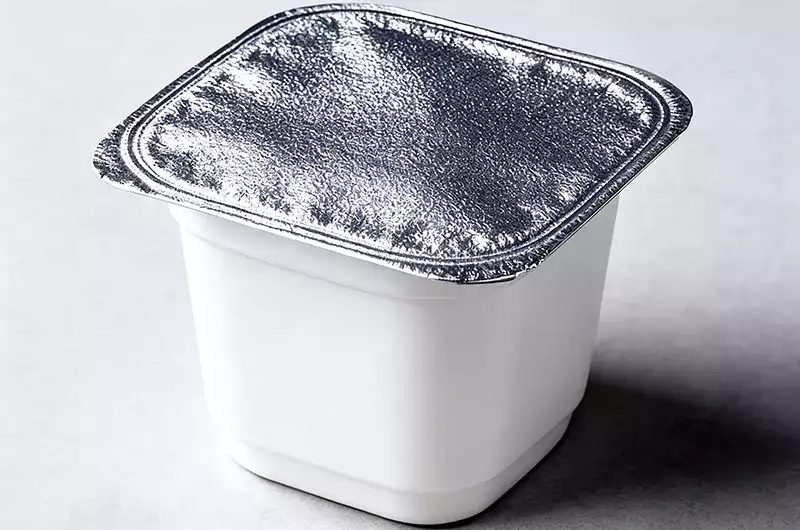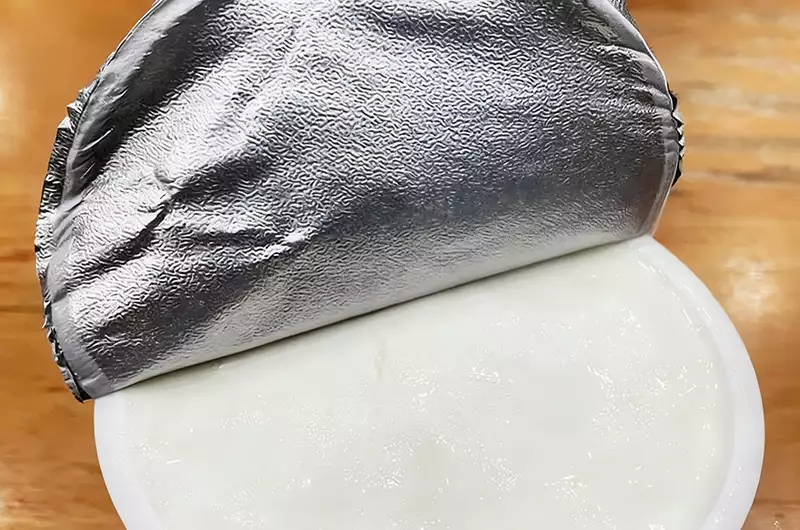Aluminum foil, as a yogurt packaging material, has become an ideal choice for yogurt packaging due to its excellent barrier properties, good heat-sealing performance, outstanding mechanical properties, and food safety assurance.
Aluminum foil can effectively block moisture, oxygen, and contaminants, thereby extending shelf life. It is usually a thin, heat-sealable foil sheet, typically coated with a layer of lacquer on one side to facilitate sealing.

- Material Structure: Yogurt packaging typically uses multilayer composite materials, with aluminum foil as the core barrier layer, an outer printed layer (such as PET/paper), and an inner heat-sealing layer (such as PP/PE).
- Common Forms: Cup lids (e.g., probiotic yogurt), inner layers of Tetra Pak cartons, sealing films of pouch yogurts, etc.
- Core Function: Protect yogurt from light, oxygen, moisture, and microbial contamination, extending shelf life.
Reasons and Advantages of Using Aluminum Foil in Yogurt Packaging
Excellent Barrier Properties
Aluminum foil plays a key role in yogurt packaging, with its most important advantage being its excellent barrier properties. Compared to plastics and other packaging materials, aluminum foil offers extremely high resistance to oxygen, moisture, light, and odors.
Superior Heat-Sealing Performance
Yogurt packaging typically uses a heat-sealing process for sealing. The compatibility of aluminum foil with heat-seal lacquers, combined with its excellent thermal conductivity and stability, makes it an ideal material for sealing and heat-sealing various plastic milk containers.
- High Temperature Resistance: Aluminum foil can withstand high temperatures without deforming, cracking, or scorching during the heat-sealing process.
- Uniform Heat Conductivity: Aluminum's excellent thermal conductivity enables fast and even heat transfer.
- Stable Sealing Performance: The combination of aluminum foil and heat-sealing layers can be designed to meet the requirements of processing and distribution.
Good Physical and Mechanical Properties
- High Strength and Toughness: Aluminum foil composite films have good strength and can withstand a certain amount of pressure and impact.
- Balanced Piercability and Puncture Resistance: High-quality aluminum foil maintains piercability while also offering a certain level of strength.
- Good Ductility: Aluminum foil has excellent ductility and dead-fold characteristics, allowing for flexible packaging according to the shape of the yogurt cup.
Food Safety and Hygiene Assurance
Food-grade safety: 8011 aluminum foil is a food-grade material—non-toxic, odorless, and non-polluting. Corrosion Resistance: A dense oxide layer on the surface of the foil gives it high corrosion resistance in the pH range of 4–8.5. Sterile Surface: No bacteria or microorganisms can grow on the surface of aluminum foil, ensuring product hygiene and safety.
Sustainability Advantages
- Recyclability: Aluminum is a fully recyclable material, and the performance of recycled aluminum is not significantly different from that of primary aluminum.
- Lightweight Design: Aluminum foil is lightweight, easy to transport and carry, and contributes to improved efficiency in transportation, storage, and distribution.
- High Product-to-Packaging Ratio: Aluminum foil has a high product-to-packaging ratio, enhancing packaging efficiency.
Types of Aluminum Foil Used in Yogurt Packaging
Common Aluminum Alloy Types
Common aluminum foil alloy types used in yogurt packaging:
- 8011 Aluminum Alloy Foil: The most commonly used alloy in yogurt packaging, known for its excellent formability and sealing performance.
- 8021 Aluminum Alloy Foil: Possesses characteristics similar to 8011, but performs better in some specific applications.
Composite Aluminum Foil Structure Types
To meet the specific needs of yogurt packaging, aluminum foil is usually combined with other materials to form multilayer composites. Common composite aluminum foil structures include:
- Polyester/Aluminum Foil/Heat-Sealing Layer (PET/AL/PE·EVA): A typical structure for easy-peel yogurt lids.
- Aluminum Foil/Heat-Sealing Layer (AL/PE): Mainly used for cost-sensitive yogurt products.
- Multilayer Composite Structure: In some high-end yogurt products, more complex multilayer composite structures may be used.
Surface Treatment Types
- Printing Treatment: To create various beautiful patterns and text on the surface of aluminum foil.
- Coating Treatment: Coated with various functional coatings, such as heat-sealing, anti-fog, anti-stick, etc.
- Embossing Treatment: Increases surface friction or creates special visual effects.
Common Specifications of Aluminum Foil for Yogurt Packaging
Thickness Specifications
The thickness of aluminum foil used for yogurt packaging is usually determined according to specific applications and performance requirements:
- Conventional Thickness Range: 0.016–0.09 mm (16–90 microns)
- Common Thickness Choices: In yogurt lid applications, the most commonly used aluminum foil thickness is 30–50 microns, typically around 38 microns.
- Thickness Variations by Part: In some specially designed yogurt packaging, foil thickness may vary in different parts.
Width and Length Specifications
The width and length of aluminum foil used in yogurt packaging are mainly determined by production equipment and packaging design:
- Width Range: Aluminum foil rolls typically range from 100 to 1700 mm in width.
- Length Specifications: Aluminum foil rolls are usually of continuous length (C) and can be slit according to customer requirements.
- Slitting Specifications: According to the specific design of yogurt cup lids, aluminum foil may be slit into specific sizes and shapes.
Performance Specifications
In addition to physical dimensions, aluminum foil used in yogurt packaging also has a series of important performance specifications:
- Mechanical Properties: Tensile strength, yield strength, elongation, cupping value, etc.
- Surface Quality: Surface cleanliness, gloss, cross-sectional quality, etc.
- Heat-Sealing Performance: Heat-sealing temperature range, heat-sealing strength, etc.
- Barrier Properties: Oxygen transmission rate, water vapor transmission rate, light barrier rate, etc.

Yogurt Packaging Aluminum Foil Chemical Composition
| Elements | Composition /% | ||
| 1235 | 8011 | 8079 | |
| Si | 0-0.65 | 0.50-0.90 | 0.05-0.30 |
| Fe | 0-0.65 | 0.60-1 | 0.70-1.30 |
| Cu | 0-0.05 | 0-0.10 | 0-0.05 |
| Mn | 0-0.05 | 0-0.20 | - |
| Mg | 0-0.05 | 0-0.05 | - |
| Cr | - | 0.05 | - |
| Zn | 0-0.1 | 0-0.10 | 0-0.10 |
| Ti | 0-0.06 | 0-0.08 | - |
| V | 0-0.05 | - | - |
| Al | Rem | Rem | Rem |
Yogurt Packaging Aluminum Foil Mechanical Properties
| Alloy | Temper | Thickness /mm | Tensile strength /MPa | elongation after break /%, (not less than) | |
| A50mm | A100mm | ||||
| 1235 | O | 0.0060 - 0.0090 | 45-95 | 0.5 | |
| 8011 8079 | 50-105 | 1.0 | |||
Yogurt Lid Aluminum Foil Functional Advantages
- Barrier Properties: Aluminum foil blocks moisture, oxygen, light, and contaminants, maintaining yogurt freshness and extending shelf life. This is crucial for protecting the fats and proteins in yogurt from oxidation.
- Heat-seal Performance: Aluminum foil ensures leak-proof seals, adjustable strength, and easy peel-off.
- Durability: Resistant to puncturing and tearing during transport, even under mechanical stress.
Yogurt Lid Aluminum Foil Applications
- Primary Use: Sealing single-serving yogurt cups and multi-pack containers.
- Expanded Applications: Dairy desserts (puddings, custards), portable snacks, and even non-food items such as cosmetics.
Aluminum foil plays a critical role in yogurt packaging by effectively blocking external factors, ensuring product quality, and providing consumer-friendly functionality.
Scope of Use: Yogurt lid films are widely used for sealing yogurt, cheese, juice, and beverage cups. Due to the high fat and protein content in yogurt, there are stringent requirements for the oxygen barrier properties of the packaging material. Aluminum foil composite lid films meet these requirements effectively.
The aluminum foil composite material used in yogurt lid films not only provides excellent sealing and barrier properties but also ensures ease of opening, maintaining the quality of the yogurt product and enhancing the consumer experience.
Haomei Yogurt Packaging Aluminum Foil Advantages
High-Quality Raw Materials
Few Holes: Haomei's 8011-O aluminum foil is precision-manufactured to ensure minimal surface holes, reducing the risk of gas and liquid permeability.
Food-Grade Safety
Oil Removal: Our aluminum foil undergoes thorough oil removal during production to ensure a clean, contaminant-free surface, meeting food-grade safety standards.
High-Temperature Tolerance: The foil can withstand high temperatures of 121°C-125°C during cooking without affecting the performance of the base material, ensuring safety and stability during food processing.
Environmental and Hygiene Standards
Compliance with National Standards: Our 8011-O aluminum foil meets national environmental and food safety technical requirements, ensuring hygiene and safety during use.
Ease of Opening: The aluminum foil lid films have excellent ease of opening properties. Even after high-temperature treatment, the sealing surface remains residue-free, ensuring product integrity and hygiene.
User Feedback
Positive Reputation: Based on user feedback, our 8011-O aluminum foil performs excellently when made into yogurt lid films, meeting various application needs with competitive pricing.
Common Issues and Solutions for Aluminum Foil Used in Yogurt Sealing
Sealing Defects and Solutions
Poor sealing is one of the most common problems in yogurt packaging, which may lead to product leakage, spoilage, or shortened shelf life:
Weak Seal or Leakage
- Possible Causes: Insufficient heat‑seal temperature, inadequate pressure, too short sealing time; contamination in the sealing area; improper choice of aluminum foil or heat‑seal coating.
- Solutions: Adjust heat‑seal parameters, clean sealing area, select appropriate materials, perform regular equipment maintenance.
Too Strong Seal Causing Difficulty in Opening
- Possible Causes: Excessively high heat‑seal temperature, overly long sealing time; unsuitable heat‑seal coating; inappropriate aluminum foil thickness.
- Solutions: Optimize heat‑seal parameters, choose a coating with suitable peel strength, adjust foil thickness, design easy‑open structures.
Uneven Sealing
- Possible Causes: Uneven pressure distribution in heat‑seal equipment; uneven surface of foil or container; insufficient sealing time.
- Solutions: Inspect and adjust equipment, ensure surface flatness, increase sealing time.
Material Compatibility Issues and Remedies
Incompatibility Between Aluminum Foil and Heat‑Seal Coating
- Possible Causes: Improper surface treatment of the aluminum foil; wrong choice of heat‑seal coating material; uneven coating thickness.
- Solutions: Choose compatible coating materials, ensure clean foil surface, control coating thickness.
Reaction Between Aluminum Foil and Yogurt Components
- Possible Causes: Yogurt pH too high or too low; insufficient protective surface coating on foil; improper storage conditions.
- Solutions: Select aluminum foil with appropriate protective coating, ensure compliance with food‑safety standards, control storage conditions.
Appearance and Quality Issues and Solutions
Surface Prints and Defects
- Possible Causes: Defects on rollers or guide rollers; unclean surfaces of sleeves or cores; foreign particles sticking to foil surface during winding.
- Solutions: Regularly clean equipment, improve storage conditions, choose reliable-quality products.
Pinhole or Holes
- Possible Causes: Roller marks on raw material surfaces; foreign particles damaging rollers during rolling; uneven foil thickness.
- Solutions: Strengthen raw material inspection, optimize rolling process, select double-layer or multilayer composite structures.
Use and Processing Issues and Solutions
Insufficient or Excessive Piercability
- Possible Causes: Improper foil thickness; inappropriate material hardness; unreasonable structural design.
- Solutions: Choose suitable foil thickness, select appropriate material hardness, optimize packaging structural design.
Difficulty in Opening
- Possible Causes: Excessive foil strength; unreasonable opening design; sealing strength too high.
- Solutions: Choose materials with appropriate strength, design easy‑to‑open structures, adjust heat‑seal parameters.
